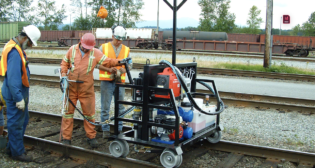
API twisting DOE report on crude oil
Written by David Thomas, Canadian Contributing EditorThe review of scientific knowledge by Sandia National Laboratory published March 24, 2015 concludes that the variability and complexity of raw crude make it impossible to predict the transportation hazard of a particular lading. Furthermore, any crude oil lading is likely to ignite in a severe accident because the energy released generates heat far in excess of the flammability thresholds of even the highest hazmat classifications.
Undaunted by this latest evidence that the cargo is the culprit in North America’s two-year succession of oil train explosions, the American Petroleum Institute rejoined that the Sandia report demonstrates the irrelevance of addressing crude oil volatility.
The API argument expressed in a March 25 news release represents a sharp about-face from its previous contention that all crude oil is safe enough to move by rail, even in the oldest DOT-111 tank cars. Now the oil lobby is agreeing that all crude oil is so inherently hazardous that the only way to prevent explosive disasters is to ensure “zero incidents” of derailment.
“The kinetic energy created by a derailment can play a far bigger role in the size of a fire than whatever the train is hauling,” said the API’s midstream director Robin Rorick.
“This report raises puzzling questions about Acting Federal Railroad Administrator Sarah Feinberg’s suggestion that nothing more can be done to prevent derailments,” said Rorick. But that is not what Feinberg said. She actually said that there is a practical limit to what can be done to keep trains on tracks, and that the oil industry shared responsibility to reduce the transportation risk of its products.
The API contends that the Sandia report found no relationship between crude oil properties and transportation risk: “The Department of Energy found no data showing correlation between crude oil properties and the likelihood or severity of a fire caused by a derailment.”
That interpretation clashes with the report’s actual language, which says the relationships are real, but not well enough understood to create a predictive model: “Although it is likely that a combination of crude oil properties—especially those associated with potential for flammable vapor formation—could be used to predict combustibility, no specific, objective data were found that correlated known crude oil properties with the likelihood or severity of rail transport-related combustion events.”
More, not less, attention to crude oil’s flammable and explosive properties is required, said the Sandia report: “[I]t is important to stress that in an accident scenario enough energy will be generated to cause ignition, far exceeding any hydrocarbon flammability classification threshold. Thus, the probability is extremely high that a combustion event will occur for a severe accident and additional parameters are needed in order to understand the hazards.”
The Sandia report makes no recommendations regarding treatment of crude oil before transportation, but it does compare “conditioning” as required starting April 1 in North Dakota to “stabilization” as practiced in Texas:
“The purpose of conditioning is to remove impurities from crude oil with the intent to eliminate compounds (typically non-hydrocarbon compounds) from the oil that lack fuel value or that unnecessarily elevate the hazard level of the petroleum, e.g., presence of toxic hydrogen sulfide. The principal purpose of stabilization, in contrast to conditioning, is to remove hydrocarbon compounds—which possess fuel value, but which also possess higher vapor pressures (i.e., have lower boiling points)—so as to reduce the volatility of the crude oil.”
An objective reading of the Sandia report shows that it is currently impossible to predict the behavior of any raw crude in a rail accident, while removal of unwanted hydrocarbon gases through stabilization does reduce volatility.



